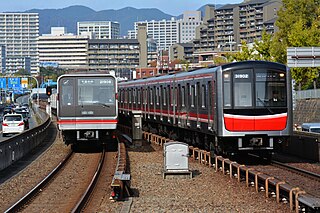This article needs additional citations for verification .(October 2020) |
| Years in rail transport |
|---|
| Timeline of railway history |
This article lists events related to rail transport that occurred in 1990.
This article needs additional citations for verification .(October 2020) |
| Years in rail transport |
|---|
| Timeline of railway history |
This article lists events related to rail transport that occurred in 1990.
| | This section is empty. You can help by adding to it. (July 2010) |

The Osaka Metro is a major rapid transit system in the Osaka Metropolitan Area of Japan, operated by the Osaka Metro Company, Ltd. It serves the city of Osaka and the adjacent municipalities of Higashiosaka, Kadoma, Moriguchi, Sakai, Suita, and Yao. Osaka Metro forms an integral part of the extensive mass transit system of Greater Osaka, having 123 out of the 1,108 rail stations (2007) in the Osaka-Kobe-Kyoto region. In 2010, the greater Osaka region had 13 million rail passengers daily of which the Osaka Municipal Subway accounted for 2.29 million.

Kyobashi Station is a railway station in the Kyōbashi district of Jōtō-ku and Miyakojima-ku, Osaka, Japan, jointly operated by West Japan Railway Company, the private railway operator Keihan Railway, and the Osaka Metro.

Nagahoribashi Station is a railway station on the Osaka Metro in Chūō-ku, Osaka, Japan. It is very close to Shinsaibashi Station, within a five minute walk.

Automatic train control (ATC) is a general class of train protection systems for railways that involves a speed control mechanism in response to external inputs. For example, a system could effect an emergency brake application if the driver does not react to a signal at danger. ATC systems tend to integrate various cab signalling technologies and they use more granular deceleration patterns in lieu of the rigid stops encountered with the older automatic train stop (ATS) technology. ATC can also be used with automatic train operation (ATO) and is usually considered to be the safety-critical part of a railway system.
Kinki Sharyo Co., Ltd. is a Japanese manufacturer of railroad vehicles based in Osaka. It is an affiliate company of Kintetsu Corporation. In business since 1920 as Tanaka Rolling Stock Works, and renamed The Kinki Sharyo Co., Ltd in 1945, they produce rolling stock for numerous transportation agencies, ranging from Shinkansen high-speed trains to light rail vehicles. Kinki Sharyo is listed on the Tokyo Stock Exchange as TYO: 7122.

The Kawasaki Railcar Manufacturing Company is the Japanese rolling stock manufacturing subsidiary of Kawasaki Heavy Industries. Since beginning operations in 1906, the company has produced more than 90,000 railroad cars.

The Osaka Metro Imazatosuji Line is a rapid transit line of Osaka Metro, running from Itakano Station in Higashiyodogawa-ku to Imazato Station in Higashinari-ku, all within Osaka city. Its official name is Rapid Electric Tramway Line No. 8 (高速電気軌道第8号線), and in MLIT publications, it is written as Line No. 8 . Station numbers are indicated by the letter I. The line first opened, at its present length, on Christmas Eve 2006.

Taisho Station is a combined railway station and metro station located in Taishō-ku, Osaka, Japan. The station is served by the Osaka Loop Line and the Nagahori Tsurumi-ryokuchi Line.
Line 6 may refer to:
Line 7 or 7 Line may refer to:

Tsurumi-ryokuchi Station is a train station on the Osaka Metro Nagahori Tsurumi-ryokuchi Line in Tsurumi-ku, Osaka, Japan. The line was opened to provide access to Tsurumi-ryokuchi Park during the 1990 International Garden and Greenery Exposition.

The Osaka Metro Nagahori Tsurumi-ryokuchi Line is an underground rapid transit system in Osaka, Japan, operated by Osaka Metro. It was the first linear motor rapid transit line constructed in Japan. Its official name is Rapid Electric Tramway Line No. 7 (高速電気軌道第7号線), and in MLIT publications, it is written as Line No. 7 . Station numbers are indicated by the letter "N".

The Osaka Metro Sakaisuji Line is an underground rapid transit line in Osaka, Japan, operated by Osaka Metro. Its official name is Rapid Electric Tramway Line No. 6 (高速電気軌道第6号線), and in MLIT publications, it is written as Line No. 6 .

Station numbering is a sign system which assigns station codes consisting of a few letters and numbers to train stations. It aims to facilitate navigation for foreign travelers not familiar with the local language by using globally understood characters. The system is now in use by various railway companies around the world such as in Mainland China, Indonesia, Japan, South Korea, Singapore, Taiwan, Thailand, and the United States.